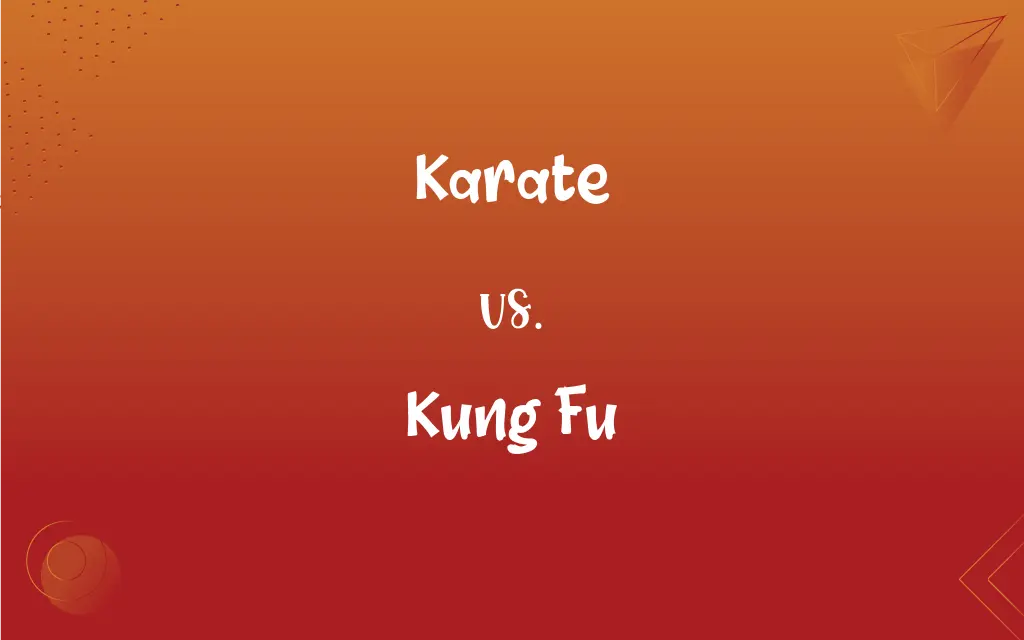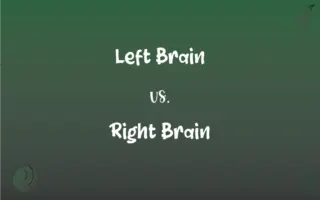Karate vs. Kung Fu: What's the Difference?
Edited by Janet White || By Harlon Moss || Updated on October 19, 2023
Karate is a Japanese martial art emphasizing striking techniques, while kung fu is a Chinese martial art with diverse styles focusing on both strikes and forms.

Key Differences
Karate is a martial art that originated in Okinawa, Japan. It places emphasis on linear punching and kicking techniques, often with a deep, stable stance. On the other hand, kung fu is a collective term used to describe various martial arts that originated in China, showcasing a vast array of techniques, forms, and philosophies.
Karate typically emphasizes power, precision, and direct movements. Many karate techniques involve straight punches, front kicks, and crisp movements, with practitioners using katas (forms) to practice combinations and techniques. Kung fu, conversely, embodies a more fluid and circular movement style. It incorporates a wide range of techniques including strikes, kicks, throws, and joint locks, often mimicking animal movements.
Karate training often stresses the importance of 'kime', or focus, concentrating all one's power into a singular strike or block. Kata, or forms, are central to karate, serving as choreographed patterns of movements that students must master. In contrast, kung fu has numerous styles, each with its own sets of forms. These forms can be short or extensive, and they often tell a story or emulate patterns found in nature.
Karate's grading system is generally characterized by different colored belts, representing a student's rank and progression. The ultimate goal for many practitioners is to achieve the black belt. Kung fu, on the other hand, doesn't universally follow a belt system. While some schools might use sashes to signify rank, others may not have any visible ranking system at all.
A common misconception is that karate is purely about striking, while kung fu solely concerns weapon use. In reality, advanced karate training can include weapons like the bo staff and nunchaku. Similarly, while many kung fu styles incorporate weapons training, a significant portion of the curriculum is dedicated to unarmed combat.
ADVERTISEMENT
Comparison Chart
Origin
Okinawa, Japan
China
Movement Style
Linear and direct
Fluid and circular
Main Techniques
Punching, kicking, and blocking
Strikes, kicks, throws, joint locks, often mimicking animal movements
Training Forms
Kata
Diverse forms depending on the style
Ranking System
Colored belts
Varies (some use sashes, others might not have a visible system)
ADVERTISEMENT
Karate and Kung Fu Definitions
Karate
A Japanese martial art emphasizing striking techniques.
She practices karate three times a week at the local dojo.
Kung Fu
An ancient Chinese fighting system that includes both armed and unarmed techniques.
Kung fu training emphasizes fluidity and adaptability in combat.
Karate
A discipline where hand and foot strikes are central.
Through karate, he learned discipline and self-defense.
Kung Fu
A collective term for Chinese martial arts.
He's been studying kung fu since he was a child.
Karate
An Okinawan art of self-defense using punches and kicks.
Karate competitions often test both sparring skills and kata performance.
Kung Fu
A holistic approach to martial arts that incorporates mind, body, and spirit.
Kung fu not only made her physically strong but also mentally resilient.
Karate
A system of combat developed in Japan focusing on unarmed techniques.
She earned her black belt in karate after years of rigorous training.
Kung Fu
A physical and philosophical practice rooted in Chinese tradition.
Besides fighting techniques, his kung fu lessons also taught him about Taoist philosophies.
Karate
A way of life for many that stresses discipline, respect, and continuous improvement.
For him, karate was more than just a sport; it was a philosophy.
Kung Fu
A martial discipline with styles often emulating animal movements.
The crane and tiger forms are popular styles within kung fu.
Karate
A Japanese martial art in which sharp blows and kicks are administered to pressure-sensitive points on the body of an opponent.
Karate
An Okinawan martial art involving primarily punching and kicking, but additionally, advanced throws, arm bars, grappling and all means of fighting.
Karate
To attack (somebody or something) with karate or similar techniques.
Karate
A traditional Japanese system of unarmed combat; sharp blows and kicks are given to pressure-sensitive points on the body of the opponent.
Karate
A traditional Japanese system of unarmed combat; sharp blows and kicks are given to pressure-sensitive points on the body of the opponent
FAQs
Is karate a sport or self-defense system?
Originally a self-defense system, karate has evolved into both a sport and a method of self-defense.
Where did karate originate?
Karate originated in Okinawa, Japan.
What is karate?
Karate is a martial art that originated in Okinawa, Japan, which emphasizes striking techniques, such as punches, kicks, and knee strikes.
Does "karate" have a specific meaning?
Yes, "karate" can be translated to mean "empty hand" in Japanese.
What's the significance of colored belts in karate?
Colored belts represent a student's rank and progress within the martial art.
Is karate part of the Olympics?
Yes, karate made its Olympic debut at the 2020 Tokyo Olympics.
Who is considered the father of modern karate?
Gichin Funakoshi is often regarded as the father of modern karate.
Is karate mainly about punches and kicks?
While punches and kicks are foundational, karate also emphasizes stances, postures, and kata (choreographed patterns of movements).
Where did kung fu originate?
Kung fu originated in China.
What's the significance of the sash in kung fu?
Sashes (often colored) are used in some kung fu schools to denote rank and progression.
Who are some famous kung fu practitioners?
Bruce Lee, Jackie Chan, and Jet Li are among the most well-known kung fu practitioners.
What is kung fu?
Kung fu is a broad term used to describe various Chinese martial arts. It emphasizes fluid movements, stances, and techniques.
Does "kung fu" mean "martial arts" in Chinese?
Not exactly. "Kung fu" can be translated to "skill achieved through hard work." While it's commonly associated with martial arts, it can refer to any skill mastered through dedication.
Are there different styles of kung fu?
Yes, there are numerous styles of kung fu, including Wing Chun, Shaolin, and Tai Chi, among others.
Is kung fu only about fighting?
No, many styles of kung fu also emphasize meditation, philosophy, and health exercises.
How does kung fu differ from karate?
While both are martial arts, they originate from different countries (China for kung fu, Japan for karate) and have distinct techniques, philosophies, and histories.
Are there different styles of karate?
Yes, there are various styles of karate, including Shotokan, Goju-ryu, and Shito-ryu, among others.
Do karate practitioners use weapons?
While basic karate focuses on "empty hand" techniques, some advanced practitioners train with traditional weapons like the bo, nunchaku, and sai.
Do kung fu practitioners use weapons?
Yes, many kung fu styles incorporate a variety of traditional weapons, such as the staff, sword, and butterfly knives.
Is kung fu part of the Olympics?
Kung fu, as wushu, has been striving for Olympic inclusion but was not an official Olympic sport as of my last update in 2022.
About Author
Written by
Harlon MossHarlon is a seasoned quality moderator and accomplished content writer for Difference Wiki. An alumnus of the prestigious University of California, he earned his degree in Computer Science. Leveraging his academic background, Harlon brings a meticulous and informed perspective to his work, ensuring content accuracy and excellence.
Edited by
Janet WhiteJanet White has been an esteemed writer and blogger for Difference Wiki. Holding a Master's degree in Science and Medical Journalism from the prestigious Boston University, she has consistently demonstrated her expertise and passion for her field. When she's not immersed in her work, Janet relishes her time exercising, delving into a good book, and cherishing moments with friends and family.































































